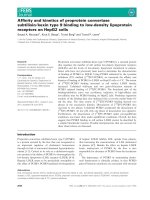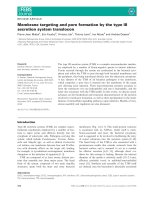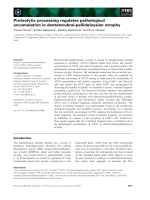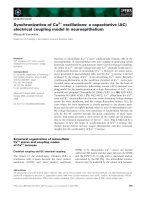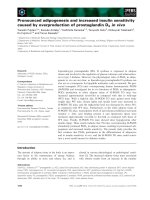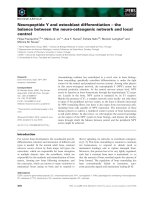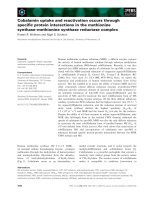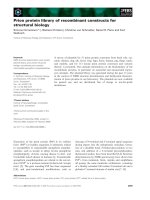Tài liệu Báo cáo khoa học: Computational processing and error reduction strategies for standardized quantitative data in biological networks doc
Bạn đang xem bản rút gọn của tài liệu. Xem và tải ngay bản đầy đủ của tài liệu tại đây (838.36 KB, 12 trang )
Computational processing and error reduction strategies
for standardized quantitative data in biological networks
Marcel Schilling
1,
*, Thomas Maiwald
2,
*, Sebastian Bohl
1
, Markus Kollmann
2
, Clemens Kreutz
2
,
Jens Timmer
2
and Ursula Klingmu
¨
ller
1
1 German Cancer Research Center, Heidelberg, Germany
2 Freiburg Center for Data Analysis and Modeling, University of Freiburg, Germany
Systems biology holds great promise for the targeted
development of therapies and more cost-effective drug
development. By combining experimental data with
mathematical modeling of the dynamic behavior of
complex biological networks [1,2], systems biology
aims to identify systems properties and to predict per-
turbation-sensitive targets. However, the major limita-
tion at present is the lack of reliable quantitative data.
To determine, test and validate the quantitative accu-
racy of models, and to capture the characteristic
dynamic behavior of systems, techniques that quantita-
tively and selectively measure biochemical reactions
within the cell must be developed [3]. Additionally, a
comprehensive set of quantitative and time-resolved
data is required to conduct a systems-level analysis [4].
Recent reports show that by analyzing quantitative
data generated using fluorescence microscopy [5], elec-
trophoretic mobility shift assays [6] or immunoblotting
[7,8], new biological insights can be obtained. How-
ever, before this approach can be used for biomedical
applications, standardized procedures for data acquisi-
tion, reliable normalization methods and generally
applicable algorithms for data processing have to be
developed.
Cellular responses are regulated by complex signaling
networks, and subtle changes in protein concentration
Keywords
data processing; error reduction;
normalization; quantitative immunoblotting;
signaling pathways
Correspondence
U. Klingmu
¨
ller, German Cancer Research
Center, Im Neuenheimer Feld 280,
69120 Heidelberg, Germany
Fax: +49 6221 424488
Tel: +49 6221 424481
E-mail:
*Authors who contributed equally to the
work presented in this article.
(Received 8 September 2005, revised 25
October 2005, accepted 27 October 2005)
doi:10.1111/j.1742-4658.2005.05037.x
High-quality quantitative data generated under standardized conditions is
critical for understanding dynamic cellular processes. We report strategies
for error reduction, and algorithms for automated data processing and for
establishing the widely used techniques of immunoprecipitation and immu-
noblotting as highly precise methods for the quantification of protein levels
and modifications. To determine the stoichiometry of cellular components
and to ensure comparability of experiments, relative signals are converted
to absolute values. A major source for errors in blotting techniques are in-
homogeneities of the gel and the transfer procedure leading to correlated
errors. These correlations are prevented by randomized gel loading, which
significantly reduces standard deviations. Further error reduction is
achieved by using housekeeping proteins as normalizers or by adding puri-
fied proteins in immunoprecipitations as calibrators in combination with
criteria-based normalization. Additionally, we developed a computational
tool for automated normalization, validation and integration of data
derived from multiple immunoblots. In this way, large sets of quantitative
data for dynamic pathway modeling can be generated, enabling the identifi-
cation of systems properties and the prediction of targets for efficient inter-
vention.
Abbreviations
CCD, charge-coupled device; ECL, enhanced chemiluminescence; Epo, erythropoietin; EpoR, erythropoietin receptor; GST, glutathione
S-transferase; HA, hemaglutinin-tagged; HRP, horseradish peroxidase; Hsc70, cellular heat shock cognate protein 70; IL-6, interleukin-6;
IP, immunoprecipitation; MAP kinase, mitogen-activated protein kinase; PDI, protein disulfide isomerase; PVDF, poly(vinylidene difluoride);
STAT, signal transducer and activator of transcription.
6400 FEBS Journal 272 (2005) 6400–6411 ª 2005 The Authors Journal compilation ª 2005 FEBS
or protein modification can trigger the onset of diseases.
For the analysis of proteins in complex mixtures, one of
the most widely used techniques is immunoblotting,
which is based on electrophoresis and transfer to a
membrane. The presence of specific proteins on the
membrane is detected by antibodies in combination
with the utilization of chemiluminescent substrates and
exposure to X-ray films. However, because the linear
range of X-ray films is very limited, quantification by
charged-coupled device (CCD) camera detection is pref-
erable [9]. For rare proteins (such as certain signaling
components), prepurification by immunoprecipitation
(IP) is required prior to immunoblotting, potentially
increasing the overall error owing to additional steps
involved in the procedure. To date, only relative values
that are difficult to compare between independent
experiments have been generated by immunoblotting.
Thus, reliable algorithms for error reduction and data
processing are required to employ immunoblotting for
the generation of high-quality quantitative data.
Another problem in normalization of data from dif-
ferent sources arises from the fact that signaling path-
ways have been primarily studied in the context of
propagatable cell lines. However, as such cell lines
have lost restrictive growth control mechanisms, it is
of great importance to analyze the behavior of signa-
ling pathways in primary cells. As material that can be
isolated from animals or patients is very limited, it is
of pressing importance that existing data be combined
and compared. Mammalian cells grow either in sus-
pension or attached to a support. Suspension cells are
primarily cells of hematopoietic origin and are partic-
ularly suited for biochemical studies on cell popula-
tions with high temporal resolution because they
permit bulk stimulation and rapid sampling. For bio-
chemical studies in adherent cells, separate stimulations
are required for each time-point, potentially resulting
in a higher sample-to-sample variation. Even more dif-
ficult is the analysis of proteins in patient samples. To
eliminate errors introduced by the measurement pro-
cess and to ensure comparability of results, we have
developed robust normalization procedures for bio-
chemical data.
We use the erythropoietin receptor (EpoR)-induced
activation of ERK1 in the hematopoietic suspension
cell line, BaF3-hemaglutinin-tagged (HA)-EpoR, and
the interleukin-6 (IL-6)-induced activation of the signal
transducer and activator of transcription (STAT)3 in
adherent primary hepatocytes, as model systems to
establish a robust procedure for error reduction and to
develop reliable algorithms for data processing, facili-
tating the generation of high-quality data by quantita-
tive immunoblotting.
Results
Standardized generation of absolute values
The reliable generation of large data sets depends on
the strategies used to achieve comparable results
among individual experiments. To achieve this, we
convert the relative signals, which are usually gener-
ated by immunoblotting, to absolute numbers, such as
molecules per cell. As an example, the abundance of
the mitogen-activated protein (MAP)-kinase family
members, ERK1 and ERK2, in cytoplasmic lysates
from BaF3-HA-EpoR cells, was determined by analyz-
ing, in parallel, a serial dilution of purified recombin-
ant ERK2 protein (Fig. 1A, upper panel). The CCD
camera-based quantification of recombinant ERK2
was plotted against the number of molecules loaded on
the gel. As demonstrated by a linear regression passing
through the origin (Fig. 1A, lower panel) and extensive
additional studies (see the Supplementary material) the
detection was linearly proportional to protein concen-
tration over at least two orders of magnitude. By using
a linear regression model (detailed in the Supplement-
ary material) relative signals of endogenous ERK1 and
ERK2 were converted to molecules per cell, indicating
that in the cytoplasm of an BaF3-HA-EpoR cell,
107 000 ERK1 molecules and 318 000 ERK2 mole-
cules are present. This determination requires the
recombinant and the endogenous proteins to be ana-
lyzed on the same immunoblot and to share the same
antibody epitope. As the CCD camera-based detection
is proportional to the number of epitopes, it can even
be applied to proteins of different molecular mass,
such as isoforms or partial fusion proteins, thus per-
mitting the concomitant determination of multiple
signaling components. In addition to ensuring compar-
ability of independent experiments, absolute values can
be used to determine the stoichiometry of cellular com-
ponents, critical for obtaining insights into the quanti-
tative behavior of biological networks.
Error determination of the measurement process
To estimate the inherent noise of data generated by
the immunoblotting technique, error determinations
were performed. A serial dilution of purified recombin-
ant ERK2 protein was analyzed eight times by immu-
noblotting using an anti-ERK immunoglobulin
(Fig. 1B, upper panel) and quantified by CCD camera-
based detection. The estimated error was calculated
as the standard deviation of the CCD camera-based
measurements. Plotting signal strength vs. estimated
error revealed that the expected error behavior of a
M. Schilling et al. Strategies for standardizing quantitative data
FEBS Journal 272 (2005) 6400–6411 ª 2005 The Authors Journal compilation ª 2005 FEBS 6401
conventional CCD camera-based photon counting pro-
cess cannot be recovered. The systematic error inherent
in this technique can phenomenologically be described
by a sublinear function. Within our measurement
range, 20% error for each data point is estimated,
whereas for weaker signals this percentage is increased
(Fig. 1B, lower panel). This noise consists of two dif-
ferent contributions: pipetting errors, which are con-
stant within a lane but uncorrelated from lane to lane;
and blotting errors, which are highly correlated from
lane to lane. Pipetting errors arise from differences in
cell number, gel loading and antibody detection, while
blotting errors are caused by inhomogeneities of the
gel or the blot.
Eliminating correlated errors by randomized
sample loading
To determine steps predominantly contributing to the
error obtained by quantitative immunoblotting analy-
sis, we monitored a time-course of erythropoietin
(Epo)-induced activation of ERK1 in BaF3-HA-EpoR
cells. Identical samples of cytoplasmic lysates were
loaded, in a randomized manner, onto two gels, trans-
ferred to membranes (blot 1 and blot 2) and analyzed
by three repetitive cycles of ERK immunoglobulin
reprobing and application of the chemiluminescent
substrate (Fig. 2A). Quantification of the signals
(Fig. 2B, upper panel) showed that the data obtained
by the two blots differed significantly. To reduce the
effects of uncorrelated errors, we employed a cubic
spline, the smoothness of which is determined by gen-
eralized cross-validation. It has been shown previously
that time-course behavior can be estimated from noisy
data by smoothing splines [10–12]. We emphasize that
a sufficiently dense grid of time-points is necessary to
keep the bias of this method small. Smoothing of the
data is performed to average over the errors contribu-
ted by pipetting, electrophoresis and transfer, and
other sources of noise.
Surprisingly, uncorrelated errors resulting from anti-
body detection and reprobing had little effect on the
results, as the splines smoothing the data obtained by
A
B
Fig. 1. Conversion of relative values to absolute protein concentra-
tions and error estimation of quantitative immunoblotting. (A) A
dilution series of recombinant ERK2 protein, as well as 100 lgof
total cellular lysate prepared from BaF3-HA-EpoR cells, were ana-
lyzed by quantitative immunoblotting with anti-ERK immunoglob-
ulin. The biomedical light unit (BLU) values of the dilution series
were plotted against the number of molecules loaded onto the gel
[amount (g)/MW
ERK2
(gÆmol
)1
) · N
A
(moleculesÆmol
)1
)] and a linear
regression through the origin was applied. The slope was used for
converting the signals of the total cellular lysate to molecules per
cell. Error bars represent estimated errors of the total ERK2 dilution
series, as determined in (B). (B) A dilution series of purified ERK2
was separated eight times by SDS ⁄ PAGE (10% acrylamide) and
transferred to a membrane that was probed with anti-ERK immuno-
globulin and subsequently developed with enhanced chemilumines-
cence (ECL) or ECL advance substrate. The estimated error of the
quantified signals was calculated as the standard deviation of the
data. To determine the noise inherent in this technique, the signal
strength was plotted vs. estimated error and was described by a
sublinear function showing a 20% error for each data point within
our measurement range.
Strategies for standardizing quantitative data M. Schilling et al.
6402 FEBS Journal 272 (2005) 6400–6411 ª 2005 The Authors Journal compilation ª 2005 FEBS
B
A
Fig. 2. Randomized sample loading ensures uncorrelated errors. (A) BaF3-HA-EpoR cells were starved and stimulated with 50 unitsÆmL
)1
erythropoietin (Epo) for 9.5 min, with samples of 1 · 10
7
cells taken every 30 s. Cells were lysed, and 75 lg of the total cellular lysate at
each time-point was separated by two 17.5% SDS polyacrylamide gels using two distinct randomized sample loading orders. Each immuno-
blot was analyzed by three repetitive cycles of detection with anti-ERK immunoglobulin and subsequent removal of the antibodies by treat-
ment with b-mercaptoethanol and SDS. The obtained signals for ERK1 were quantified by LumiImager analysis. (B) The data show strongly
correlated errors when arranged in gel loading order, which are specific for a particular blot but are not affected by reprobing procedures. By
arranging the data in chronological order, these correlations are eliminated and the data can be smoothed by spline approximations, as indi-
cated by solid lines. Randomization reduced the standard deviation of the smoothing splines by a factor of 14.
M. Schilling et al. Strategies for standardizing quantitative data
FEBS Journal 272 (2005) 6400–6411 ª 2005 The Authors Journal compilation ª 2005 FEBS 6403
successive reprobing of the same blot were nearly iden-
tical. However, the analysis revealed that the data
obtained for neighboring lanes was strongly correlated.
The apparently different results obtained for identical
samples showed that the blotting error leads to aber-
rant dynamic behavior. Detailed analysis of large data
sets revealed a strong correlation between neighboring
lanes in immunoblotting analysis, resulting in substan-
tial systematic errors. To separate this spatial correla-
tion from true temporal dynamics in time-course data,
we developed standard operating procedures for rand-
omized sample loading, separating consecutive time-
points by a minimum number of lanes. This loading
scheme was varied from experiment to experiment to
minimize gel border effects. The procedure thereby
ensures uncorrelated errors (Fig. 2B, lower panel) and
thus facilitates the detection of true dynamic behavior.
In this case, randomization reduced the standard devi-
ation of the smoothing splines from 18.6% to 1.4%
and thus significantly improves the data quality.
Data correction using normalizers
To reduce the effect of the blotting error and improve
the data quality, we used endogenous proteins as
normalizers. The time-course of Epo-induced phos-
phorylation of ERK1 was detected by immunoblotting
using a phosphospecific anti-pERK immunoglobulin
(Fig. 3A). Subsequently, the antibody was removed
and the blot was reprobed, first with an anti-ERK
immunoglobulin to determine the total amount of
ERK1 in the cytoplasmic lysates and, second, with a
mixture of antibodies against endogenous proteins.
These proteins, which we termed normalizers, are
highly expressed, their levels are not changed during
the course of the experiment and antibodies are avail-
able that permit efficient detection. As shown in
Fig. 3A, the blotting error is strongly influenced by the
position of a protein within a blot, as evidenced by the
analysis of bActin (42 kDa), protein disulfide iso-
merase (PDI; 58 kDa), and heat shock cognate protein
70 (Hsc70; 73 kDa) covering the entire separation
range of the polyacrylamide gel. Therefore, the signal
of a normalizer of similar molecular mass to the pro-
tein of interest has to be used to distinguish blotting
error from the true protein concentration. The levels
of pERK1 and ERK1 were normalized with a smooth-
ing spline applied to the bActin signal. As shown in
Fig. 3B, this procedure enabled us to correct for blot-
ting errors in our signals. As expected, the normalized
data shows a constant concentration of ERK1 over
the entire observation time. By employing purified
ERK2 as standard, relative signals for ERK1 were
converted to molecules per cell and the proportion of
phosphorylated ERK1 was determined by analyzing
the fraction of protein that was detected by the anti-
ERK immunoglobulin at a higher position in the blot.
This ensures the comparability of normalized data
derived from independent experiments.
Recombinant proteins as calibrators for IP
For certain proteins, immunoblotting is not capable of
generating quantitative data. This problem can be
caused by antibodies with weak affinity to the protein,
cross-reaction with other proteins resulting in a high
background, or by the use of generic phosphotyrosine
antibodies. In such cases, the protein of interest has to
be prepurified by IP, prior to electrophoresis.
As normalizers are not captured by the antibodies
used for the IP, we have established a method to cor-
rect for blotting errors as well as inaccuracies in the
multistep IP procedure, and to normalize the results
obtained. We generated proteins (which we termed
calibrators) that share the same epitope as the protein
of interest, but differ in molecular mass. Adding a
defined amount of calibrator to the lysate prior to IP
permits normalization of the results obtained by CCD
camera-based detection. We fused the protein domain
containing the epitope of the antibody used for IP to a
affinity tag for purification (Fig. 4A). Using only part
of the protein, calibrators of large proteins or trans-
membrane proteins could easily be expressed in
Escherichia coli and purified using affinity beads. We
determined the concentration of the calibrators by ana-
lyzing a BSA dilution series and the calibrator in a
Coomassie Blue-stained gel and quantifying the sig-
nals. To define the optimal amount of calibrator that
should be added to the IP while still avoiding satura-
tion of the antibodies, increasing concentrations of the
calibrator, glutathione S-transferase-tagged (GST)-
EpoR, were added to lysates of BaF3-HA-EpoR cells
prior to IP (Fig. 4B). Plotting the concentration of cal-
ibrator added to the lysates vs. signals for HA-EpoR
and GST-EpoR showed that the calibrator signal
increased linearly in a range between 2.5 and 100 ng.
This suggested that the use of a calibrator not only
permits quantitative data generation, but also conver-
sion of relative values to absolute protein concentra-
tions. The addition of the calibrator had no effect on
the signal for the HA-EpoR up to concentrations of
500 ng of GST-EpoR, indicating that the antibody was
in large excess compared with HA-EpoR. Using this
data, we calculated that 40 ng of GST-EpoR should
be added to lysates to obtain comparable signals for
HA-EpoR and the calibrator (Fig. 4C).
Strategies for standardizing quantitative data M. Schilling et al.
6404 FEBS Journal 272 (2005) 6400–6411 ª 2005 The Authors Journal compilation ª 2005 FEBS
Using calibrators for error reduction
The impact of calibrators on data quality is exempli-
fied by an EpoR time-course experiment with
randomized gel loading. We stimulated BaF3-HA-
EpoR cells with Epo for up to 10 min and added
40 ng of GST-EpoR to each cytoplasmic lysate to con-
trol for errors during the IP procedure (Fig. 5A). In
B
A
Fig. 3. Correction of phosphorylated and total ERK1 signals using normalizers. (A) BaF3-HA-EpoR cells were starved and stimulated with 50
unitsÆmL
)1
erythropoietin (Epo) for 9.5 min, with samples of 1 · 10
7
cells taken every 30 s. Cells were lysed and 75 lg of total cellular lysate
at each time-point was separated by electrophoresis on a 17.5% SDS polyacrylamide gel. The immunoblot was analyzed with anti-pERK
immunoglobulin, and then reprobed, first with anti-ERK immunoglobulin and second with an anti-heat shock cognate protein 70 (Hsc70) ⁄
anti-protein disulfide isomerase (PDI) ⁄ anti-(bActin) immunoglobulin mixture. All signals were quantified by LumiImager analysis. (B) The
bActin signal was spline-smoothed and used to normalize pERK1 and ERK1 signals, having similar molecular masses. pERK1 and ERK1 sig-
nals were converted to number of molecules per cell using the protein standard depicted in Fig. 1. Smoothing spline curves through original
and normalized data are shown as solid lines.
M. Schilling et al. Strategies for standardizing quantitative data
FEBS Journal 272 (2005) 6400–6411 ª 2005 The Authors Journal compilation ª 2005 FEBS 6405
addition, the calibrator was used to correct for blotting
errors, thereby significantly improving data quality.
However, correction steps can be detrimental to the
data if a calibrator yields noisy signals or is exposed to
different gel ⁄ transfer inhomogenieties as the protein of
interest owing to a large difference in molecular mass.
We therefore developed criteria for automated data
correction in IP experiments, as described in the
Supplementary material. One necessary condition for
these criteria is randomized sample loading. As shown
in the Supplementary material, by combining random-
ized sample loading with calibrators, the standard
deviation of immunoblotting data can be improved by
more than twofold. The corrected data (Fig. 5B) show
the expected behavior of a continuous increase in
phosphorylated HA-EpoR and a constant level of total
HA-EpoR for 10 min after stimulation with Epo.
Computational data processing using
GELINSPECTOR
For automated data processing and to permit data
merging of samples analyzed on separate blots, we
developed the computer algorithm gelinspector. This
algorithm calculates smoothing splines for the normal-
izers or calibrators and normalizes blotting data using
these splines. Furthermore, the program verifies the
normalization, integrates multiple data sets and visual-
izes the results. To validate our approach, we investi-
gated the effect of our algorithm on time-course data
generated from primary hepatocytes. We combined
sample randomization with criteria-mediated error
reduction using Calnexin and Hsc70 as normalizers.
By loading time-points alternating on two gels, the
number of data points that could be analyzed together
was increased beyond the capacity of a single gel
(Fig. 6A). Applying gelinspector enabled us to nor-
malize the signals and significantly decrease the stand-
ard deviation from a smoothing spline, resulting in
time-course data with a high temporal resolution
(Fig. 6B). The high reproducibility of the time-course
dynamics for phosphorylated and total cytoplasmic
STAT3 obtained by immunoblotting of cytoplasmic
lysates, as well as immunoprecipitates (data not
shown), demonstrated that our automated computa-
tional data processing is robust and reliably applicable
for both methods. These tools facilitate the standard-
ized and automated generation of quantitative data
and permit the cost-effective assembly of large, high-
quality data sets.
Discussion
Quantitative data generation is becoming increasingly
important for obtaining insight into the dynamic
behavior of complex biological networks, to elucidate
systems properties and to predict targets for biomedi-
cal applications. We show that by randomized sample
loading and computational data processing, including
criteria-based normalization, high-quality quantitative
data can reliably be generated by immunoblotting, a
C
B
A
Fig. 4. Titration of the glutathione S-transferase tagged-erythropoie-
tin receptor (GST-EpoR) calibrator in immunoprecipitation. (A) The
domain structure of hemaglutinin-tagged HA-EpoR is schematically
depicted and the binding epitope for the anti-EpoR immunoglobulin is
indicated. The calibrator, GST-EpoR, consists of the protein domain
containing the antibody-binding site fused to an affinity tag for purifi-
cation. (B) BaF3-HA-EpoR cells were starved, stimulated with 50
unitsÆmL
)1
erythropoietin (Epo) for 5 min and lysed. Increasing
amounts of recombinant GST-EpoR were added to the lysates and
both the GST-EpoR calibrator and the HA-EpoR were immunoprecipi-
tated with anti-EpoR immunoglobulin. The samples were separated
on a 10% SDS polyacrylamide gel. The immunoblot was analyzed
with anti-EpoR immunoglobulin and quantified by LumiImager analy-
sis. (C) Concentrations of the calibrator were plotted vs. the signals
obtained for the HA-EpoR and the GST-EpoR calibrator. A red line
depicts the linear relationship between the calibrator concentration
added to the lysate and the detected signal within a range of
2.5–100 ng of calibrator addition. The blue line depicting the average
signal of the HA-EpoR intersects at 40 ng of GST-EpoR, indicating
comparable signals for the calibrator and the HA-EpoR.
Strategies for standardizing quantitative data M. Schilling et al.
6406 FEBS Journal 272 (2005) 6400–6411 ª 2005 The Authors Journal compilation ª 2005 FEBS
widely applied technique. By systematically determin-
ing steps contributing to the variability of the experi-
mental data, we identified gel and transfer
inhomogeneities as the major source for correlated
errors. These correlations could be eliminated by
randomized sample loading, and error reduction was
achieved by the use of normalizers or calibrators in
combination with computational data processing. By
converting relative signals to absolute values, compar-
able results can be obtained from independent
A
B
Fig. 5. Correction of hemagglutinin-tagged-erythropoietin receptor (HA-EpoR) signals with the glutathione S-transferase (GST)-EpoR calibra-
tor. (A) BaF3-HA-EpoR cells were starved and stimulated with 50 unitsÆ mL
)1
erythropoietin (Epo) for the indicated time. A total of 1 · 10
7
cells was lysed and 40 ng of GST-EpoR was added to each lysate. Immunoprecipitation was performed using anti-EpoR immunoglobulin,
followed by separation on a 10% SDS polyacrylamide gel with randomized sample loading. The immunoblot was analyzed with anti-pTyr and
anti-EpoR immunoglobulin and quantified by LumiImager analysis. (B) Time after Epo stimulation was plotted against the signals of HA-EpoR
and the calibrator GST-EpoR. A spline smoothing the calibrator signal was used to correct pEpoR signals, whereas the EpoR signal was
corrected and converted to molecules per cell. Splines are depicted as solid lines.
M. Schilling et al. Strategies for standardizing quantitative data
FEBS Journal 272 (2005) 6400–6411 ª 2005 The Authors Journal compilation ª 2005 FEBS 6407
experiments and used for the assembly of large sets of
quantitative data.
Randomized sample analysis is a general strategy to
prevent correlated errors, for example in double-blind
comparative clinical studies [13] and in the design of
DNA microarray experiments [14]. Here, we use this
approach to separate spatial blotting effects from real
changes in protein levels (i.e. their true dynamic behav-
ior). By simulations of typical time-course experiments,
we demonstrated that randomization reduces the
standard deviation of immunoblotting data by more
than twofold (see the Supplementary material for
simulations). Sample randomization is thus a simple
procedure that significantly improves data quality
without increasing experimental efforts.
To reduce errors inherent in blotting techniques,
such as inhomogeneities in the gel as well as transfer,
normalizers are used that are present at a similar
position in the blot as the molecule of interest and
which are detectable with a strong constant signal. We
identified several housekeeping proteins of different
molecular mass that can be reliably used as normaliz-
ers. The normalization procedure cannot be applied if
a normalizer differs too much in molecular mass from
the protein of interest because it is exposed to different
gel ⁄ transfer inhomogenieties and therefore does not
permit an adequate estimation to be made of the blot-
ting error. To ensure accuracy of data normalization,
we applied spline approximation and developed data
processing criteria. The resulting computer algorithm,
gelinspector, compares the standard deviation of
both the normalized and the unprocessed data to a
first estimate of the values. Only if the normalized val-
ues are closer to the estimate, is normalization by
computational data processing accurate and results in
significantly improved data quality.
A
B
Fig. 6. Quantitative data generation of primary hepatocytes using the computer algorithm GELINSPECTOR. (A) Primary mouse hepatocytes
were prepared from mouse livers. A total of 2 · 10
6
cells for each time-point was cultured on collagen-coated dishes and starved. Interleu-
kin-6 (IL-6) was added (40 ngÆmL
)1
) and the cells were lysed at the indicated time-points. Cytoplasmic lysates were separated by two 10%
SDS polyacrylamide gels. Sample loading was randomized with every second time-point on the second gel. Quantitative immunoblotting was
performed with anti-phosphorylated signal transducer and activator of transcription 3 (pSTAT3), anti-signal transducer and activator of transcrip-
tion (STAT3), and an anti-Calnexin ⁄ anti heat shock cognate protein 70 (Hsc70) mixture. (B) Immunoblotting data were automatically processed
by
GELINSPECTOR using Calnexin ⁄ Hsc70 signals as normalizers, and the data points were spline-smoothed, as indicated by solid lines.
Strategies for standardizing quantitative data M. Schilling et al.
6408 FEBS Journal 272 (2005) 6400–6411 ª 2005 The Authors Journal compilation ª 2005 FEBS
In the case of grouped data, such as mutant to wild-
type comparisons used in diagnostic approaches, the
first estimate is the mean value of the same sample loa-
ded in replicates. In other cases, where a continuous
dependency exists (such as in time-course or in dose–
response experiments), the first estimate is a regression
curve if the functional relationship is known or a
smoothing spline if unknown. These functions are
implemented in gelinspector.
Our method is not only applicable to proteins con-
centrated by IP, but also, as we show in Fig. 6A, for
the detection of proteins in total cellular lysates of pri-
mary hepatocytes. Furthermore, our data processing
procedures permit the quantification of low abundance
proteins, or modifications, as demonstrated for the
Epo-induced phosphorylation of ERK1⁄ 2 (Fig. 3A).
The EpoR, a member of the hematopoietic cytokine
receptor family, activates the MAP kinase signaling
cascade to a much lesser extent than receptor tyrosine
kinases, such as the epidermal growth factor receptor
or the platelet derived growth factor receptor.
Similarly to normalizers, calibrators added in IP
experiments permit criteria-based data normalization.
Importantly, calibrators, in addition, facilitate the con-
version of relative signals to absolute values, such as
molecules per cell. For the analysis of cellular lysates,
this can be achieved by coloading known amounts of
recombinant proteins onto the gel, which are detected
by the same antibody as the protein of interest. Using
microscopic techniques, the volume of a cell can be
estimated, allowing conversion of molecules per cell to
protein concentrations. The generation of absolute val-
ues provides additional information regarding absolute
protein concentrations that cannot only be used to
compare signals derived from independent immunoblot
experiments, but also to identify the amount of a given
protein in a single cell and to determine the stoichiom-
etry of cellular components [15].
The proposed methods can be applied to other blot-
ting techniques, such as northern and Southern blot-
ting analysis, as inhomogeneities in gel and transfer
are likely to cause correlated errors in all blotting data.
Similarly, correlations can be eliminated by randomi-
zation and the errors can be reduced by criteria-based
normalization.
Recently developed strategies for quantitative deter-
mination of protein levels and modifications include
mass spectrometry techniques based on isotope-coded
affinity tags [16] and isotope-coded protein labels [17].
By labeling different samples with distinct isotopes, rel-
ative changes can be quantified using mass spectrome-
try. It is even possible to determine absolute values by
the addition of synthesized peptides of known quanti-
ties as standards. However, these methods are still very
expensive, technically demanding and have the dis-
advantages of requiring large amounts of cellular
material.
By developing quantitative immunoblotting as a
robust and reliable technique for quantitative data
acquisition under standardized conditions, we establish
an easy to handle and cost-effective alternative that
permits the assembly of large data sets with high tem-
poral resolution. This provides an important tool for
diagnostic purposes and the targeted development of
novel therapeutic applications.
Experimental procedures
Cell lines and primary cell cultures
The retroviral expression vector, pMOWS, containing
HA-EpoR cDNA, was introduced into BaF3 cells by retro-
viral transduction. Cell lines stably expressing HA-EpoR
(BaF3-HA-EpoR) were selected and maintained in RPMI
1640 (Invitrogen, Carlsbad, CA, USA) in the presence of
puromycin.
Primary hepatocytes were isolated from male Black-6
mice (6–8 weeks old) (Charles River, Wilmington, MA,
USA). Livers were perfused with Hanks buffer supplemen-
ted with collagenase II (Biochrom, Berlin, Germany).
Experiments were carried out in accordance with the
German Animal Welfare Act of 12 April 2002 and the
European Council Directive of 24 November 1986. Intact
liver capsules were transferred into Williams’ medium
(Biochrom) supplemented with fetal bovine serum, insulin,
l-glutamine and dexamethasone. Hepatocytes were
removed from the capsules, enriched by centrifugation and
cultured on collagen I-coated dishes (BD Biosciences,
Franklin Lakes, NJ, USA) in Williams’ medium E (Bioch-
rom) supplemented with l -glutamine and dexamethasone.
Expression, purification and quantification of
recombinant proteins
Unphosphorylated purified ERK2 was purchased from Cell
Signaling Technologies (Beverly, MA, USA). The cytoplas-
mic domain of the EpoR was cloned into pGEX-2T (Amer-
sham Biosciences, Piscataway, NJ, USA) and expressed in
E. coli BL21 CodonPlus-RIL bacteria (Stratagene, La Jolla,
CA, USA). Proteins were extracted by lysozyme lysis and
sonication. Glutathione agarose beads (Sigma-Aldrich, St
Louis, MO, USA) were added to lysates and proteins were
eluted by the addition of reduced glutathione (Sigma-
Aldrich). For the quantification of purchased and purified
proteins, dilution series of purified BSA (Sigma-Aldrich)
and the recombinant proteins were separated by 10%
SDS ⁄ PAGE and stained with Coomassie Brilliant Blue.
M. Schilling et al. Strategies for standardizing quantitative data
FEBS Journal 272 (2005) 6400–6411 ª 2005 The Authors Journal compilation ª 2005 FEBS 6409
The gel was documented using the trans-illumination mode
of a LumiImager (Roche Diagnostics, Mannheim,
Germany). Proteins were quantified using lumianalyst
software (Roche Diagnostics).
Time-course experiments
BaF3-HA-EpoR cells were starved for 5 h in RPMI 1640
(Invitrogen) supplemented with 1 mgÆmL
)1
BSA (Sigma-
Aldrich) and then stimulated with 50 unitsÆmL
)1
Epo
(Cilag-Jansen, Bad Homburg, Germany). For each time-
point, 10
7
cells were taken from the pool of cells and lysed
by the addition of 2 · Nonidet P-40 lysis buffer, thereby
terminating the reaction.
A total of 2 · 10
6
primary hepatocytes were cultured for
24 h after plating on collagen I-coated 60 mm dishes (BD
Biosciences) in Williams’ medium E (Biochrom) supple-
mented with l-glutamine and dexamethasone. Cells were
starved for 5 h in Williams’ medium E supplemented with
l-glutamine. Each dish was stimulated with 40 ngÆmL
)1
IL-6
in Williams’ medium E containing l-glutamine. The medium
was removed from the cells, 1 · Nonidet P-40 lysis buffer
was added, and cells were collected using a cell scraper.
Immunoprecipitation and quantitative
immunoblotting
For IP, cytosolic lysates were incubated with anti-EpoR
immunoglobulin (Santa Cruz, La Jolla, CA, USA) or
anti-STAT3 immunoglobulin (Cell Signaling Technologies).
Immunoprecipitated proteins and total cellular lysates
were separated by SDS ⁄ PAGE and transferred to
poly(vinylidene difluoride) (PVDF) or nitrocellulose mem-
branes. Proteins were immobilized with Ponceau S solu-
tion (Sigma-Aldrich) followed by immunoblotting analysis
using the anti-phosphotyrosine mAb, 4G10 (Upstate Bio-
technology, Lake Placid, NY, USA), the anti-(tyrosine
phosphorylated STAT3) immunoglobulin or the anti-(dou-
ble phosphorylated p44 ⁄ 42 MAP kinase) immunoglobulin
(both Cell Signaling Technologies). Antibodies were
removed by treating the blots with b-mercaptoethanol and
SDS, as described previously [18]. Reprobes were per-
formed using anti-EpoR (Santa Cruz), anti-STAT3 or
anti-(p44 ⁄ 42 MAP kinase) (both Cell Signaling Technol-
ogies) immunoglobulins. For normalization, antibodies
against bActin (Sigma-Aldrich), PDI, Hsc70 and Calnexin
(all Stressgen, Victoria, Canada) were used. Secondary
horseradish peroxidase (HRP)-coupled antibodies (anti-
rabbit HRP, anti-mouse HRP, protein A HRP) were pur-
chased from Amersham Biosciences. Immunoblots against
phosphorylated EpoR and total EpoR were incubated
with enhanced chemiluminescence (ECL) substrate (Amer-
sham Biosciences) for 1 min, and exposed for 10 min on a
LumiImager (Roche Diagnostics). All other immunoblots
were incubated with ECL Advance substrate (Amersham
Biosciences) for 2 min, and exposed for 1 min on a Lu-
miImager (Roche Diagnostics). For quantifications,
lumianalyst software (Roche Diagnostics) was used.
Spline approximation and signal normalization
Smoothing splines were applied to the noisy data to esti-
mate the actual values. Their smoothness was determined
by generalized cross-validation, minimizing the mean square
error between the estimated time-course and the data
[10,12]. Splines were used for criteria-mediated error reduc-
tion by gelinspector, as described in the Supplementary
material.
Computational data processing by
GELINSPECTOR
The computer algorithm gelinspector requires matlab 6.5
and the freely available statistics environment R1.9 or above.
It visualizes the blotting error in a gel domain, rearranges
randomized gel loadings into chronological order, applies the
presented criteria-mediated normalization procedure, and
merges data deriving from one experiment measured on sev-
eral gels. Choices to calculate a first estimate include con-
stant, sigmoidal and spline functions. Splines are calculated
using the mgcv library [11] from R or the matlab spline tool-
box. After specifying proteins of interest, normalizers, cali-
brators, the measurement files and some global options (such
as the preferred figure format pdf, eps, jpg or png), gelin-
spector works completely automatically. Figures of all
important steps, and files with the processed data, are cre-
ated. gelinspector is available from the authors.
Acknowledgements
We thank Stefan Rose-John for the generous gift of
IL-6, Sabine McNelly for technical help with hepato-
cyte preparation and Jan G. Hengstler for the develop-
ment of standard operating procedures for the
preparation of primary hepatocytes. We also thank
Nils Blu
¨
thgen and Peter J. Nickel for helpful sugges-
tions and Ute Baumann for excellent technical assist-
ance. We are grateful to Jennifer Reed for critically
reading the manuscript.
This work was supported by the funding priority
‘Systems of Life – Systems Biology’ of the German
Federal Ministry of Education and Research (BMBF).
References
1 Kholodenko BN, Demin OV, Moehren G & Hoek JB
(1999) Quantification of short term signaling by the epi-
dermal growth factor receptor. J Biol Chem 274, 30169–
30181.
Strategies for standardizing quantitative data M. Schilling et al.
6410 FEBS Journal 272 (2005) 6400–6411 ª 2005 The Authors Journal compilation ª 2005 FEBS
2 Schoeberl B, Eichler-Jonsson C, Gilles ED & Muller G
(2002) Computational modeling of the dynamics of the
MAP kinase cascade activated by surface and interna-
lized EGF receptors. Nat Biotechnol 20, 370–375.
3 Bhalla US, Ram PT & Iyengar R (2002) MAP kinase
phosphatase as a locus of flexibility in a mitogen-acti-
vated protein kinase signaling network. Science 297,
1018–1023.
4 Kitano H (2002) Systems biology: a brief overview.
Science 295, 1662–1664.
5 Nelson DE, Ihekwaba AE, Elliott M, Johnson JR,
Gibney CA, Foreman BE, Nelson G, See V, Horton
CA, Spiller DG et al. (2004) Oscillations in NF-kappaB
signaling control the dynamics of gene expression. Sci-
ence 306, 704–708.
6 Hoffmann A, Levchenko A, Scott ML & Baltimore D
(2002) The IkappaB-NF-kappaB signaling module: tem-
poral control and selective gene activation. Science 298,
1241–1245.
7 Swameye I, Muller TG, Timmer J, Sandra O & Klingmul-
ler U (2003) Identification of nucleocytoplasmic cycling
as a remote sensor in cellular signaling by data-based
modeling. Proc Natl Acad Sci USA 100, 1028–1033.
8 Bentele M, Lavrik I, Ulrich M, Stosser S, Heermann
DW, Kalthoff H, Krammer PH & Eils R (2004) Mathe-
matical modeling reveals threshold mechanism in CD95-
induced apoptosis. J Cell Biol 166, 839–851.
9 Feather-Henigan K, Hersey S, Johnson A, Milosevich
GM & Hines K (1999) Immunoblot imaging with a
cooled CCD camera and chemiluminescent substrates.
Am Biotechnol Lab 17, 44–46.
10 Craven P & Wahba G (1979) Smoothing noisy data
with spline functions. Numer Math 31, 377.
11 Wood SN (2003) Thin plate regression splines. J R Sta-
tist Soc B 65, 95–114.
12 Green P & Silverman B (1994) Nonparametric Regres-
sion and Generalized Linear Models. Chapman & Hall,
London.
13 Hill AB (1951) The clinical trial. Br Med Bull 7, 278–
282.
14 Kerr MK (2003) Design considerations for efficient and
effective microarray studies. Biometrics 59, 822–828.
15 Li M & Hazelbauer GL (2004) Cellular stoichiometry of
the components of the chemotaxis signaling complex.
J Bacteriol 186, 3687–3694.
16 Gygi SP, Rist B, Gerber SA, Turecek F, Gelb MH &
Aebersold R (1999) Quantitative analysis of complex
protein mixtures using isotope-coded affinity tags. Nat
Biotechnol 17, 994–999.
17 Schmidt A, Kellermann J & Lottspeich F (2005) A
novel strategy for quantitative proteomics using isotope-
coded protein labels. Proteomics 5, 4–15.
18 Klingmuller U, Lorenz U, Cantley LC, Neel BG &
Lodish HF (1995) Specific recruitment of SH-PTP1 to
the erythropoietin receptor causes inactivation of JAK2
and termination of proliferative signals. Cell 80, 729–
738.
Supplementary material
The following supplementary material is available
for this article online:
D
OC. S1. Computational processing and error reduc-
tion strategies for standardized quantitative data in bio-
logical networks.
This material is available as part of the online article
from
M. Schilling et al. Strategies for standardizing quantitative data
FEBS Journal 272 (2005) 6400–6411 ª 2005 The Authors Journal compilation ª 2005 FEBS 6411
